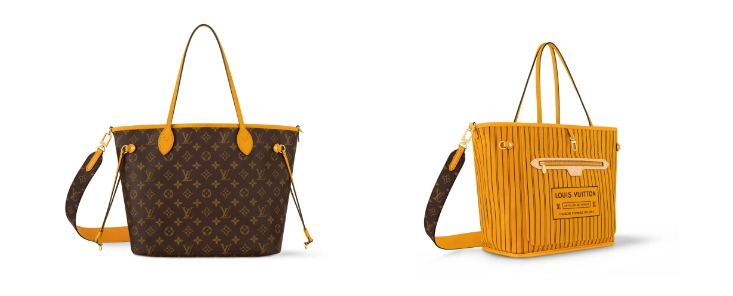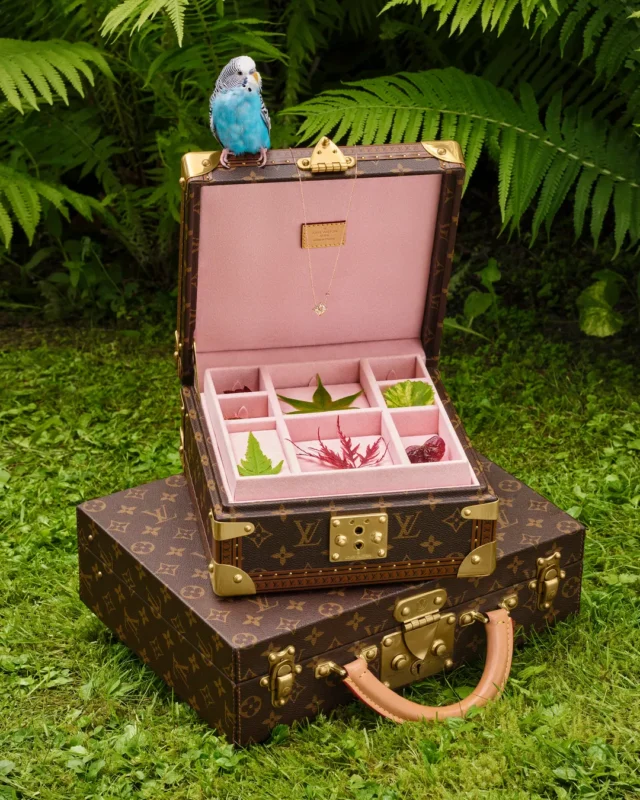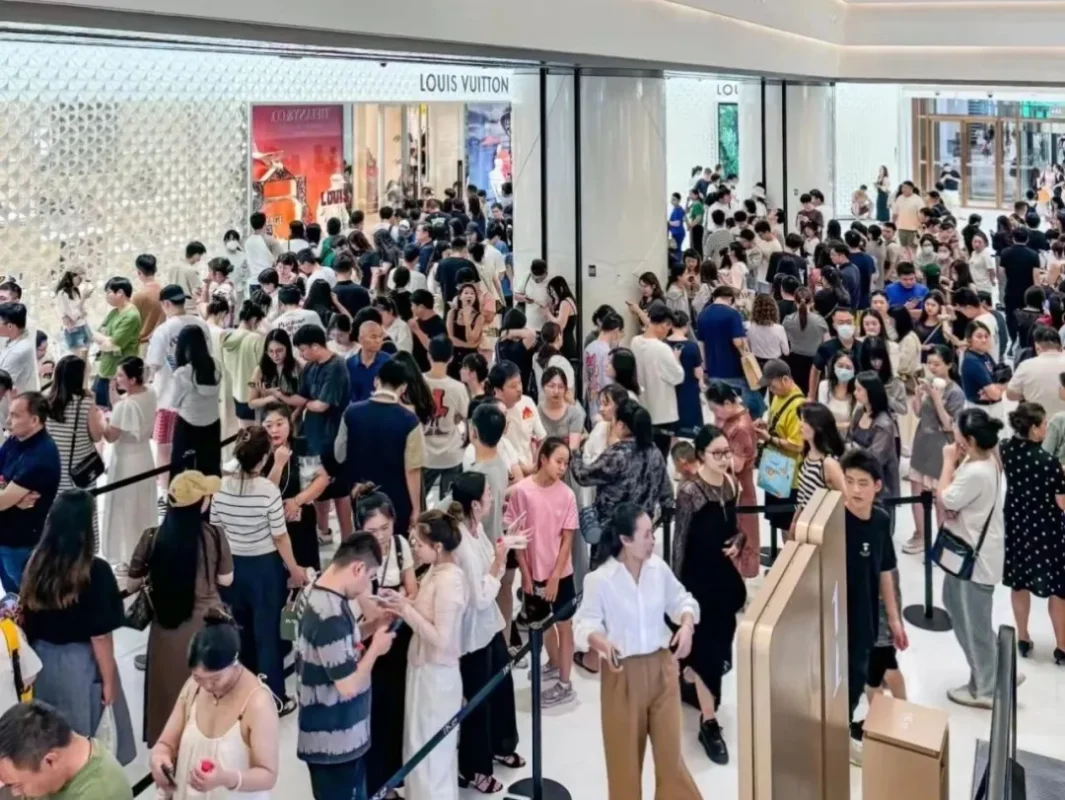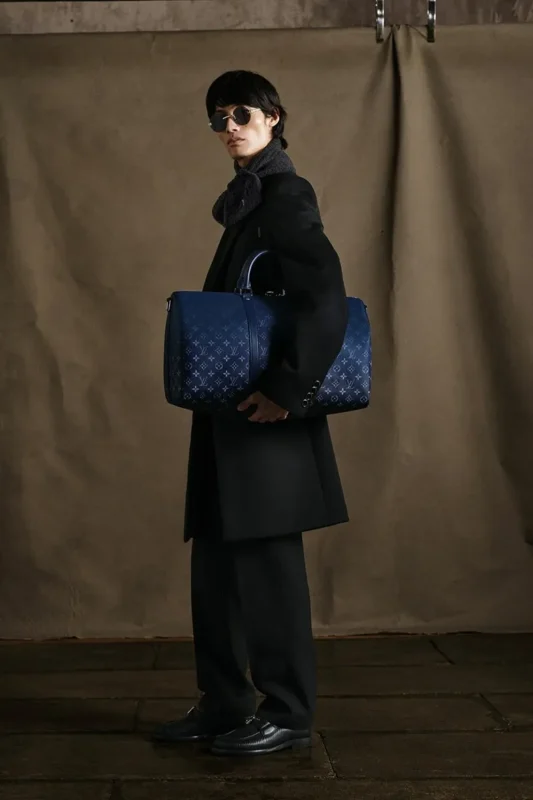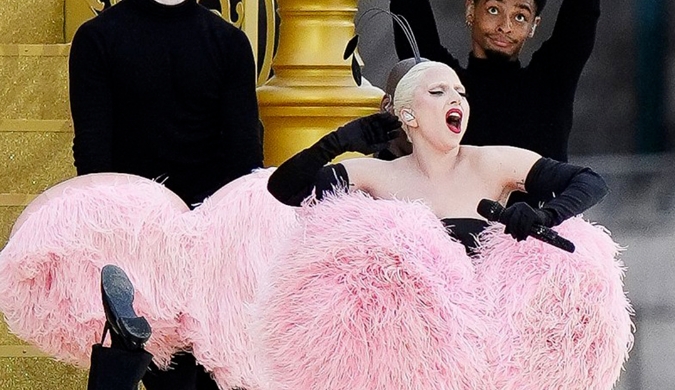It only takes five years for celebrity designers to shift from industry focus to marginalized individuals.
As rap star Kanye West was heavily promoting his upcoming album Vultures, the fashion brand Yeezy, founded by him, announced last Thursday that Russian designer Gosha Rubchinskiy was the design director, attracting close industry attention. The market speculates that the new album “Vultures” features a series of graphic designs and merchandise that differ from previous creative styles, all of which were created by Gosha Rubchinskiy.
At the same time, Gosha Rubchinskiy, a brand with the same name, announced on its social media account that it will break away from COMME des GAR æ ONS and branch brand Rassvet to embark on a new creative path and invest in new collaborative projects.
Gosha Rubchinskiy’s comeback, which should have topped the headlines of major media outlets, ultimately did not spark widespread discussion in the fashion industry. After experiencing a round of metabolism, the mass market dominated by the younger generation has become unfamiliar with this complex name.
Although Gosha Rubchinskiy has been working through projects such as Rassvet and GR Uniforma since the closure of the eponymous brand in 2018, it has largely disappeared.
Between 2015 and 2018, the strong rise of post Soviet aesthetics became an industry phenomenon, not only deeply influencing popular fashion trends, but also becoming the main object of academic analysis. As the Three Musketeers leading the aesthetics of the post Soviet era and the street style of Eastern Europe, Demna, Gosha Rubchinskiy, and Lotta Volkova worked together to transform the high-end fashion industry.
If Supreme, Yeezy, and Off White broke through half of the high walls of European haute couture with American street culture, then Eastern European street culture broke through the other half.
Demna, a celebrity designer who rose to fame from Vetements, continued to expand her influence through Balenciaga, not only continuing in the high-end clothing field, but also restarting Balenciaga’s high-end customization series. Stylist Lotta Volkova, who once contributed to the image development of Vetments and Gosha Rubchinskiy, has now become the mastermind behind Miu Miu’s fashion phenomenon.
Gosha Rubchinskiy originally had the potential to further transform the fashion industry.
Although initially Gosha Rubchinskiy was just a men’s clothing brand established in Moscow, Russia, far from the fashion centers of Europe and America, with a theme of youth subculture, Gosha Rubchinskiy was able to break through various barriers and truly penetrate the industry center with several key springboards.
With the help of Anna Dyulgerova, the Russian Vogue fashion editor, Gosha Rubchinskiy met Adrian Joffe, the husband of Baoling Kawaguchi and President of COMME des GAR č ONS. In 2012, she officially reached a production and distribution agreement with COMME des GAR č ONS International to sell in top tier stores such as Dover Street Market.
With the endorsement of the most successful designer business system in history, COMME des GAR ç ONS, Gosha Rubchinskiy has been able to thrive in the fashion industry since then. Not only did she make her debut at Paris Fashion Week in 2014, but more importantly, she solved the most headache inducing business management problem for independent designer brands, which has always been Gosha Rubchinskiy’s weakness.
Gosha Rubchinskiy, born in 1984, excels in shaping typical images of Russian youth. By directly recruiting amateur models, he allowed teenagers to step onto the runway with their real identities. They are both group portraits and individual narratives, growing up with various emerging and mixed pop cultures in the 1990s, attempting to find themselves through music and skateboarding in the cold climate and monotonous lifestyle.
The brand broke the stereotypical impression of Russia in the Western world, giving a group of young people a real and vivid image, and making them curious about various emerging cultures during the rising globalization period, and trying to find authenticity in the confusion of modern crises, the Western world quickly accepted it.
It is necessary to point out that both Demna and Lotta Volkova stand out in this critical context, as their works reflect a true and unadorned attitude towards life from Eastern European culture, and are expected to break the power structure of Western fashion.
Although Gosha Rubchinskiy clearly cites symbols of Russian social culture in his works, using Cyrillic letters as the prominent label of the brand, he is unwilling to provide answers compared to delving into macro issues of right and wrong, and also has a photographer identity.
Compared to his identity as a designer, he identifies more with the identity of a visual creator. He is willing to ask questions and truthfully record the lives of these teenagers. Compared to aggressive ideological output, this attitude that appears fresh but lacks substantive criticism is more easily accepted by the Western world.
The alliance with adidas in 2017 was not only a successful commercial collaboration between Gosha Rubchinskiy as a designer brand and a German sports giant, but also a cultural resonance.
Starting from the autumn and winter of 2017, Gosha Rubchinskiy has been collaborating with adidas for three consecutive seasons, building momentum for the 2018 FIFA World Cup hosted by Russia and sponsored by adidas.
Gosha Rubchinskiy has chosen the release location for the 2017 autumn/winter collection in Kaliningrad, which currently belongs to Russia but remained in Germany until World War II, and has also invested nearly one-third of the entire collection in adidas collaboration products inspired by football. In 2018, Gosha Rubchinskiy and adidas Football continued to jointly launch the World Cup.
To some extent, adidas has helped Gosha Rubchinskiy further enhance its brand influence. Adidas has a unique meaning in Russian culture, and their intersection can be traced back to the 1980 Moscow Games, when the Soviet sports delegation as the host did not choose local clothing manufacturers, but rather adidas.
This controversial measure sparked interest among young people in the former Soviet Union in adidas. In the former Soviet Union, where genuine copies were hard to find, a large number of counterfeit adidas sportswear seized the market and were welcomed by young people who were extremely eager for fashion. The most recognizable three stripes became an important symbol of the country’s youth culture.
The collaboration with adidas in 2017 attracted a large following for Gosha Rubchinskiy, while the collaboration with British luxury brand Burberry in 2018 continued to take the brand to new heights, creating the most highly anticipated collaboration project at the time, apart from LV and Supreme.
At that time, Burberry, led by Christopher Bailey, was facing a transformation dilemma and had been struggling for a long time before finally deciding to integrate into the rising global street culture trend. Burberry, as the most representative British luxury brand, has been plagued by identity issues for many years. The brand once intentionally reduced its use of plaques in the mid-2000s to maintain its elite position due to excessive use of plaques among a group of commoners known as Chav.
But due to the global infiltration of street culture, Burberry has regained plaid and collaborated with Gosha Rubchinskiy, who excels in depicting Russian civilian youth.
In terms of cultural significance, the collaboration between Burberry and Gosha Rubchinskiy may be more challenging than the collaboration between LV and Supreme. The former concerns social class, while the latter only involves the struggle between new and old money.
Until today, Burberry has not been able to solve its identity issue. The current creative director Daniel Lee’s debut series on plaid still faces criticism in the UK domestic market, and his goodwill towards the young commoner class has alerted a group of people.
Looking back from this perspective, although Gosha Rubchinskiy became a tool for Burberry’s transformation process, it also made it a part of the high-end fashion system in fact. Integrating into the system as a rebel, Demna has since proven its feasibility.
On many levels, Gosha Rubchinskiy is typical.
In business, people can see how designer brands have broken into the global mainstream fashion stage, integrated into the designer brand’s segmented markets, and established a business system. Later, they successfully launched the independent brand Rassvet for skateboarding. The two key collaborations with adidas and Burberry have enriched Gosha Rubchinskiy’s own brand culture and provided a model for the collaboration model in the fashion industry.
In terms of cultural attributes, Gosha Rubchinskiy stands at many intersections. After Soviet or Eastern European aesthetics, German retro sports culture, subculture skateboarding branches, and even broader global trend culture, Gosha Rubchinskiy blends all cultural trends together. But at the same time, the brand has established a real community through amateur casting, leading many street brands to innovate their brand interaction forms in the future.
In the exploration of youth culture, the fashion industry has established a coherent thread from Raf Simons and Hedi Slimane, to Gosha Rubchinskiy, and now to the controversial Corteiz teenagers and Opium kids, making fashion a mirror of social culture. Gosha Rubchinskiy’s social record on this issue could have continued to deepen, but unfortunately it came to an abrupt end.
At a series of nodes where potential energy converges, the sudden fall of Gosha Rubchinskiy is actually full of contingency.
In March 2018, at its peak, Gosha Rubchinskiy suddenly decided to stop the eponymous brand. Gosha Rubchinskiy expressed that she is tired of the work rhythm of season after season. But at that time, Gosha Rubchinskiy was discussing new work and production models with COMME des GAR æ ONS, planning to launch a new brand.
However, in December 2018, according to social media accounts such as Diet Prada, Gosha Rubchinskiy was targeted at underage models for photos, sparking speculation and questioning among netizens about the designer’s pedophilia. The situation became uncontrollable, and Gosha Rubchinskiy subsequently cleared her social media account and issued a statement stating that some media outlets took out of context and distorted the facts.
A spokesperson for the Gosha Rubchinskiy brand explained that at the time, the brand was conducting a role selection for amateur models, and the person involved voluntarily sent a letter to apply. However, due to the inability of people around to take photos, the designer requested the model to take photos in the bathroom as soon as possible for unified archiving. The brand emphasizes that it has been recruiting amateur models for many years and has not encountered similar problems in the previous decade.
Adidas became the first brand to respond to the controversy at the time, stating that it had hired relevant agencies to investigate and claim compensation for the incident, but refused to disclose details. Adrian Joffe, President of COMME des GAR č ONS, who helped produce and sell Gosha Rubchinskiy products, expressed his trust in Gosha Rubchinskiy and his disgust with the increasing frequency of online violence at the time.
Now it seems that this accusation lacks evidence other than chat screenshots, and it ultimately came to an end without any investigation results being made public. But Gosha Rubchinskiy’s reputation has suffered substantial damage since then and has never been repaired, which has to some extent affected its subsequent project development.
The historical background that cannot be ignored by chance is that in 2018, Cancel culture boycotted the peak of culture in the fashion industry. In January 2018, more than 20 male models who caused a sensation in the industry accused fashion photographers Bruce Weber and Mario Testino of sexual harassment, leading to the termination of their collaboration with Contina. Before and after this incident, there were continuous accusations from various sectors of society, and the controversy over Gosha Rubchinskiy occurred amidst the frenzy of social media boycotts.
The Thousand Mile Embankment was destroyed in an ant colony, and the brand momentum accumulated by Gosha Rubchinskiy over ten years was interrupted. But the inevitability behind this is that, unlike the ambitious Demna who judges the situation, the Gosha Rubchinskiy, which peaked at stopping the brand, dislikes the system.
Demna is an ambitious person who judges the situation. The Vetements founded by Demna Gvasalia after giving up on their own initiative sparked intense discussions in the industry. Abandoning Vetments and pursuing a luxury brand job stems from Demna’s more realistic pursuit of her career, voice, and influence.
In Balenciaga, Demna almost gradually washed away the influence of native aesthetics, retaining the creation technique of luxury goods for daily things, but removing the specific background of Eastern European aesthetics. He cleverly transformed the emotions of the war era in the former Soviet Union into a kind of globalized apocalyptic complex, in order to meet the commercial needs of Balenciaga as a globalized luxury brand.
In 2021, Demna re launched a high-end customization collection for Balenciaga, reaffirming Balenciaga’s status as a high-end fashion house. He also changed his personal title from full name Demna Gvasalia to Demna, removing surnames suggestive of Eastern European background, thus officially opening a new chapter in his personal identity. Afterwards, the relationship between Demna and his brother Guram Gvasalia, who is now solely in charge of Vetements, also openly deteriorated.
In 2022, Demna launched adidas collaboration in Balenciaga, but Balenciaga’s presentation was overshadowed by the deeply ingrained collaboration between Gosha Rubchinskiy and adidas.
The essential difference between the two series is that Gosha Rubchinskiy and adidas, based on a certain historical and cultural origin, achieved effective chemical effects at the right time of the World Cup in Russia. However, Balenciaga’s cooperation with adidas seemed to be a purely commercial collaboration to stir up the topic. At that time, adidas was in a low performance period and was eager to achieve success in its fashion strategy through cooperation with Gucci and Balenciaga.
Dramatically, by the end of 2022, Demna, who had been making great strides for several seasons, was also deeply embroiled in scandals, forcing the brand’s positive momentum to be interrupted. However, unlike Gosha Rubchinskiy’s proactive retreat, Demna chose to hold on, using the slogan of returning to the essence of making clothes, and fought for a “second chance” in her career.
In order to compete for business in the currently sluggish US market, Demna is willing to release the latest 24 Autumn series in Los Angeles, USA, with the theme of the lifestyle of wealthy Americans. Despite Demna’s satire on American cultural phenomena, it still reflects her current level of collaboration as a professional creative director.
On the other hand, Lotta Volkova has gradually moved the market’s early discussion of its binding with Eastern European aesthetics into a stage of focusing on Lotta Volkova’s personal style, thanks to her creative contributions to Prada’s sister brand Miu Miu.
Within five years, not only has the fashion industry shed its skin, but the macro world has also undergone a tremendous transformation.
After the outbreak of the Russia Ukraine crisis in 2022, the Western context urgently cut ties with Russian culture. Natalia Vodianova, the daughter-in-law and supermodel of the Arnault family of LVMH Group, withdrew from social media due to public pressure. Russian socialites such as Miroslava Duma, who used to be active in the front row of fashion shows, have also faded out of sight, and the mainstream fashion power in Russia is increasingly fading.
Fashion is a microcosm of the changing tide of the times.
Author J E. Sebastian argued in a 2017 column that there were two reasons for the prevalence of New Russian aesthetics at that time. Firstly, it was an ancient romantic sentiment that was highly susceptible to strangeness, mystery, and taboos.
The second point is a new concept of globalization, hoping that people can understand and get along with each other in their own unique ways. These Russian designers perfectly meet these two points. They aroused people’s curiosity by proposing a strange new concept that represents open opposition; By presenting people with a unified aesthetic, and more importantly, as a styling style that people can buy in London, Paris, or New York, they offer this idea to people, just like an iPhone or Louis Vuitton handbag.
The fashion industry’s pursuit of new Russian aesthetics stems from curiosity, but now this curiosity has dissipated.
This is clearly not good news for Gosha Rubchinskiy’s comeback. He unexpectedly formed an alliance with Kanye West, two previously unrelated figures, not only because they shared a common civilian ideal, but also because they were in a marginalized and tainted camp, or more frankly, a villainous alliance in public opinion.
In a recent video leaked on social media, Kanye West loudly accused herself of not receiving any support in the crisis caused by anti Semitic controversy, and named Demna, who was estranged from Kanye West due to the crisis at the time.
It can be seen that the relationship between Demna, Kanye West, Gosha Rubchinskiy, who used to wear Vetements’ famous DHL T-shirt but now stands behind Kanye West, and Lotta Volkova, who no longer collaborates with Demna and has been implicated in the Balenciaga controversy since 2019, has become complex and difficult to understand.
Recently, Balenciaga, Yeezy, and Vetements have launched similar sock boots, which is a clear manifestation of this complex relationship. The old alliance has shattered, and the creative alliance that once faced the Western fashion world together is just an interlude.
It is worth noting that both Demna and Lotta Volkova, who have received fashion education, have developed new languages. However, it remains to be seen whether Gosha, a non science student who has been stripped of the support of Russian cultural context, is still Gosha.
What kind of culture should Gosha, who is more of a cultural recorder than a product, focus on? This is his personal challenge in the second half.
After the peak of global resistance to culture, whether society’s reflection and correction of this culture can bring a second opportunity to Demna, Gosha, and Kanye West is a larger collective proposition.

